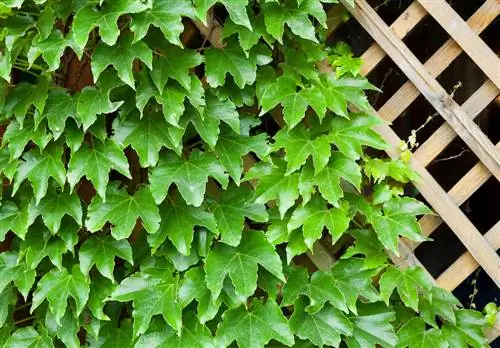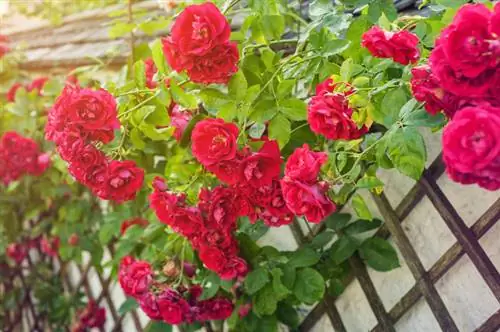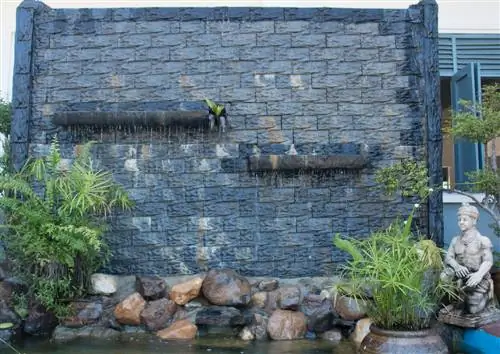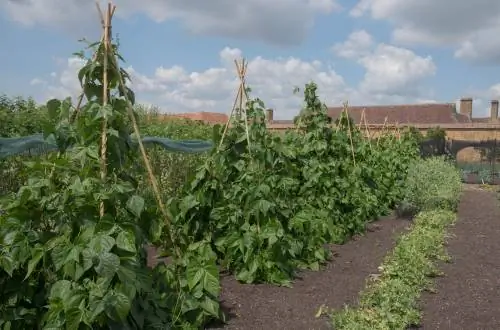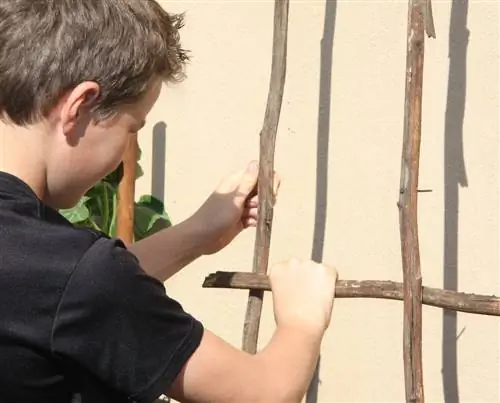- Author admin [email protected].
- Public 2023-12-16 16:46.
- Last modified 2025-01-23 11:21.
Some plants strive upwards but cannot find support on their own. Their tendrils are naturally either too thin or too soft, or both. To ensure that no plant withers on the ground, we should offer it a climbing aid. Anyone can build one easily and cheaply themselves.
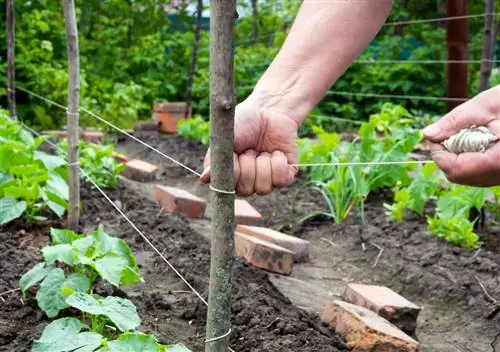
How can I build a climbing aid myself?
To build a climbing aid yourself, you need sturdy rods, ropes or grids, depending on the type of plant. Bamboo sticks are suitable for twiners, wooden trellises for spreader climbers and rope systems for petiole tendrils. Self-climbers require a climbing aid mounted on walls.
Different climbers
Many plant species require a firm hold when climbing. If you look closely, you'll notice that they hold on to it differently. The following list names the best-known groups with some typical representatives.
- Leaf-stem vines: clematis, peas, bottle gourd, nasturtium
- Self-climbing: ivy, Virginia creeper, climbing hydrangea
- Spreading climbers: blackberries, climbing roses, firethorn
- Twisting: runner beans, morning glories; Kiwi
Requirements for trellises
It depends on the type of plant what the climbing aid has to be like in order to really be a supporting aid. The way in which it conquers the trellis plays just as much of a role as its weight, which has to be supported by the scaffolding. Clarify these points before selecting the material for the climbing aid.
Leaf-stem tendrils have a rather low weight, so the framework does not have to be very stable. It mainly consists of thin cords, rods, ropes, etc. Thick bars cannot be included.
More stable rope systems or wooden grids must be provided for spreader climbers. Crawlers need strong, vertical rods around which they can twist.
Self-climbing
Selfclimbers can hold on to walls with their adhesive organs and thus get by without additional climbing aid. However, they leave such serious marks and sometimes damage the substance that a climbing aid is strongly recommended.
Trailer support for creepers
This trellis is the easiest to build because you only need one sufficiently sturdy rod per plant. It is best to stick this close into the soil when sowing or planting out so that the young plant can easily reach it.
- thick bamboo sticks or horse mackerel
- Metal or plastic stakes from the garden center
The sticks have the advantage that they are mobile and can be placed in another place as a climbing aid the following year.
Tip
Corn is an ideal, living climbing aid for runner beans, which also gives us delicious corn on the cob. As soon as the corn has reached a height of approx. 30 cm, 3-5 beans are planted next to each pole.
Stable and durable trellis
If you grow your own vegetables in the garden, you can definitely use a sturdy trellis. Different plants can alternate between them. Below are the instructions for a two meter long trellis.
- Get three sturdy wooden posts that are 2 m long and a net (€11.00 on Amazon) that is approx. 3 m long. The mesh size should be 10 x 10 mm. A non-slip material that is also weather-resistant is ideal.
- Drive a post approx. 50 cm deep into the ground. To ensure that the wood is better protected from soil moisture, you can use suitable ground sleeves.
- Drive in the other two posts in a straight line, 1 m apart from each other.
- Stretch the net over the entire area and attach it firmly to the three wooden posts.
Wall scaffolding as a climbing aid
If you want to grow a climbing plant close to a building, you should provide it with scaffolding as soon as possible. Since it cannot be easily expanded or replaced later, it must be large enough from the start to support the fully grown plant. Stable slats made of weather-resistant wood are ideal.
- Ensure air circulation between the plant and the wall
- at least There must be a distance of 10 cm from the wall
- install appropriate spacers
- then attach two long slats vertically
- if necessary several
- attach crossbars to it
- approx. Leave 30 to 40 cm between them
Tip
Small scaffolding can also be pre-assembled and then firmly connected to the wall.
Trellis for potted plants
Climbing plants are popular as balcony greenery because they quickly provide a dense privacy screen. They usually grow in a pot or balcony box and require a climbing aid. You can easily build this yourself from a few bamboo sticks.
- Stick 2 long bamboo sticks into the ground
- attach 3-5 short bamboo sticks horizontally to it
- each with a distance of approx. 20 cm
- Use woolen threads, cable ties or binding wire
- if applicable. tie in a fan shape; narrow at the bottom, wider at the top
Tip
Some plants cannot hold on to the trellis and must therefore be tied at regular intervals.


